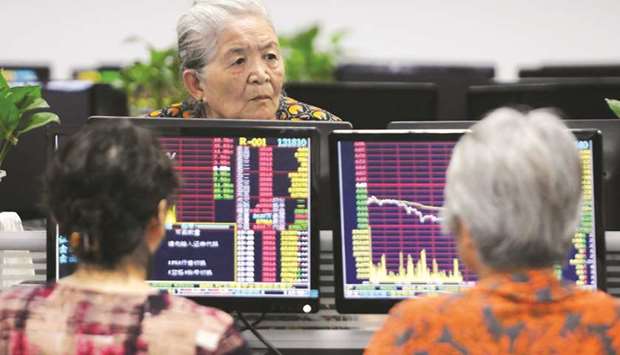With Washington and Beijing threatening tit-for-tat moves over import tariffs, investors are worried a trade war will act as a brake on China’s economy and hollow out an already deflating equity market.
Selling intensified last week after data showed weak spots in China’s economy. Rising corporate defaults and the government’s financial deleveraging campaign are also undermining sentiment. But the death of buy-the-dip is all the more dramatic at a time when company profits are rising, a sign that investor pessimism may be snowballing beyond repair.
“Seeing the benchmark dropping below the 3,000 level hurts sentiment even more,” said Hao Hong, chief strategist with Bocom International Holdings Co in Hong Kong. “Things could get a lot worse if the trade war escalates and China fights back in an unconventional way. I would advise against buying into the selloff.”
China yesterday said it will retaliate “forcefully” after President Donald Trump threatened duties on $200bn in Chinese imports, and another $200bn after that if Beijing retaliates. It follows last week’s publication of the US’s final list of $50bn in tariffs, and China’s statement over the weekend that all recent agreements on trade would become void.
Trump’s tariffs dealt a blow to a market that’s yet to recover from a $5tn collapse that began almost exactly three years ago. The Shanghai Composite is among the world’s worst performing benchmarks this year – only a handful of emerging markets have fared as bad. Almost 80% of the Chinese index’s stocks closed at fresh four-week lows yesterday. Even foreign investors, who had been faithful buyers of yuan-denominated shares for 29 consecutive sessions via the exchange links with Hong Kong, turned net sellers.
While the Shanghai Composite Index now trades at less than 11 times projected earnings, it’s cheapest relative to global shares since early 2015, bargain hunters are hard to find.
It’s too early to call the bottom in mainland equities, especially as the US has yet to officially implement tariffs on Chinese products and any restrictions on investment from China, according to Louis Lu, a fund manager at CSOP Asset Management in Hong Kong. He expects more volatility as talks continue in the summer months.
“Investors were surprised that Trump changed his attitude so fast,” Lu said. “Previously they expected a good result after the Singapore summit and the Chinese government’s favourable monetary policy.”
The rout has taken the benchmark below even the most bearish year-end forecast from December, blindsiding strategists’ calls for a better performance this year. Traders had previously speculated that China’s so-called national team would be committed to defending the 3,000 level, which proved to be a key level of support for stocks at the beginning of last year.
“It’s perceived as a place where the government steps in and moves the levers,” said Ritesh Jain, a Mumbai-based chief investment officer at BNP Paribas Asset Management India Private. “This heavy hand should appear soon, though I’m not sure it would have a lasting effect unless monetary policy is eased, the currency is allowed to fall or a fiscal lever is used.”
With little sign of state intervention, bearish sentiment may persist, even as the Shanghai Composite closed at a technical level that may signal it’s dropped too far, too fast.
“We have to be cautious,” said Stephen Innes, head of trading at Oanda Corp in Singapore. “This escalation is weighing on the big macro picture and probably wise not to pick bottoms.”



